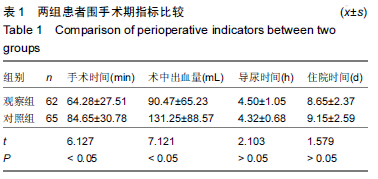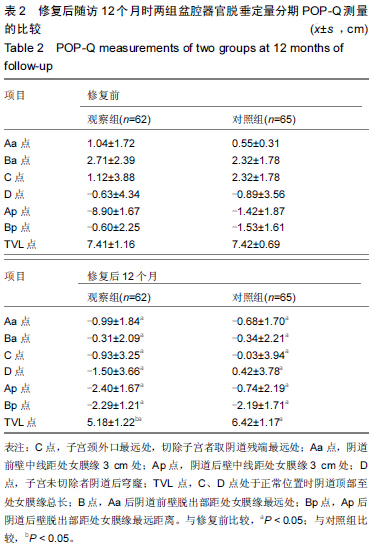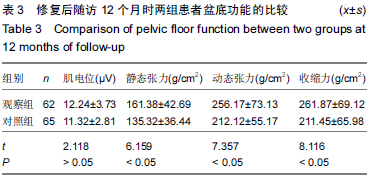|
[1] 李怀芳,童晓文.聚丙烯网片在女性全盆底功能重建中的应用[J].中国实用妇科与产科杂志,2007,23(8):602-604.
[2] 朱兰,娄文佳,郎景和,等.无穿刺加用网片盆底重建术治疗症状性Ⅱ~Ⅲ度盆腔器官脱垂的近期疗效分析[J].实用妇产科杂志, 2011,27(3):201-203.
[3] 陈娟,朱兰,郎景和,等.Prosima 网片全盆底重建术治疗重度盆腔器官脱垂的前瞻性研究[J].中华妇产科杂志,2012, 47(9): 664-668.
[4] 黄晨玲子,林鑫子,罗新,等.合成网片对比阴道修补术治疗女性盆腔器官脱垂的meta分析[J].中国微创外科杂志,2014,(12): 1128-1134.
[5] Wiegersma M,Panman CM,Kollen BJ,et al.Pelvic floor muscle training versus watchful waiting or pessary treatment for pelvic organ prolapse (POPPS): Design and participant baseline characteristics of two parallel pragmatic randomized controlled trials in primary care.Maturitas.2014;77(2):168-173.
[6] Due U,Brostrøm S,Lose G.Validation of the pelvic floor distress inventory-20 and the pelvic floor impact questionnaire-7 in danish women with pelvic organ prolapse. Acta Obstet Gynecol Scand. 2013;92(9):1041-1048.
[7] 秦岳,刘蓉.全盆底网片悬吊术治疗老年妇女盆腔器官脱垂疗效观察[J].山东医药,2011,51(38):73-74.
[8] 庄雅丽,何娟,汪海妍,等.盆腔器官脱垂应用网片术后疗效观察[J].现代妇产科进展,2010,19(5):355-357.
[9] 许歌,王玲,李荷莲,等.应用不可吸收网片盆底重建术治疗Ⅲ~Ⅳ度盆腔器官脱垂的疗效[J].中国老年学杂志,2014,34(16): 4555-4557.
[10] 邱骏,王弓力,郭玉娜,等.全盆底重建术在盆腔器官脱垂中的应用[J].上海医学,2010,33(7):670-673.
[11] 陈信良,童晓文,李怀芳,等.全盆底网片悬吊术治疗老年女性盆腔器官脱垂184例的疗效[J].上海医学,2007,30(8):599-601,封2.
[12] 谢红斌,林雪燕.子宫切除对全盆底重建疗效的影响[J].中国妇幼健康研究,2014,25(5):878-880.
[13] 王素美,张震宇,刘崇东,等.盆底重建术同时行TVT-O治疗盆腔器官脱垂及压力性尿失禁临床疗效评价[J].中华妇产科杂志,2013, 48(7):494-498.
[14] 韩劲松,张坤,朱馥丽,等.经阴道网片植入手术治疗盆腔器官脱垂的临床分析[J].中华妇产科杂志,2011,46(2):101-104.
[15] 马宁,王凤玫,黄惠娟,等.改良Prolift网片盆底重建术对压力性尿失禁防治作用的探讨[J].中华妇产科杂志,2012,47(7):505-509.
[16] 李炳琪,郑春兰,王春昱,等.盆底重建术治疗盆腔器官脱垂的术后短期疗效观察[J].中国妇幼保健,2013,28(20):3365-3367.
[17] Kim JY, Kim EJ, Jeon MJ,et al.Association between the poly(ADP-ribose) polymerase-1 gene polymorphism and advanced pelvic organ prolapse.Menopause. 2014;21(2): 177-181.
[18] 周丽仙,毛嘉平,陶跃平,等.改良式网片盆底重建术治疗盆腔器官脱垂[J].中国基层医药,2011,18(7): 897-898.
[19] 朱兰,娄文佳.一种适用于症状性中重度盆腔器官脱垂的加用网片盆底重建手术[J].中华妇产科杂志,2011,46(5):384-385.
[20] 蔡贤君,郭延荣.61例盆腔器官脱垂两种手术方法疗效观察[J].中国妇幼保健,2013,28(15):2471-2474.
[21] Kashyap R,Jain V,Singh A.Comparative effect of 2 packages of pelvic floor muscle training on the clinical course of stage I-III pelvic organ prolapse.Int J Gynaecol Obstet. 2013;121(1): 69-73.
[22] 朱兰,陈娟.美国妇科泌尿协会“经阴道植入网片治疗盆腔器官脱垂的手术医师资格认证指南”解读[J].中华妇产科杂志,2013, 48(2):159-160.
[23] Dillon BE,Seideman CA,Lee D,et al.A surprisingly low prevalence of demonstrable stress urinary incontinence and pelvic organ prolapse in women with multiple sclerosis followed at a tertiary neurogenic bladder clinic.J Urol.2013; 189(3):976-979.
[24] 肖勇,陈玲,何文静,等.prolift全盆底重建术治疗重度盆腔器官脱垂19例近期疗效观察[J].南昌大学学报:医学版,2012,52(6): 39-41.
[25] Shalom DF,Lin SN,St Louis S,et al.Effect of age, body mass index, and parity on Pelvic Organ Prolapse Quantification system measurements in women with symptomatic pelvic organ prolapse.J Obstet Gynaecol Res.2012;38(2):415-419.
[26] 刘小春,朱兰,郎景和,等.应用全盆底重建术治疗重度盆腔器官脱垂临床分析[J].中国医学科学院学报,2011,33(2):180-184.
[27] 张迎辉,鲁永鲜,刘昕,等.盆底重建术后阴道聚丙烯网片暴露对患者生命质量的影响[J].中华妇产科杂志,2012,47(8):608-611.
[28] 陈婉珺,刘艳霞,陈欢,等.经阴道Prosima网片联合高位骶韧带悬吊术治疗重度盆腔器官脱垂的围术期护理[J].实用临床医药杂志,2013,17(10):91-94.
[29] 鲁永鲜,王佳,沈文洁,等.经阴道子宫骶骨韧带高位悬吊术治疗重度盆腔器官脱垂的长期疗效[J].中华妇产科杂志,2013,48(8): 564-569.
[30] 蒋军,梁月琴,王建芬,等.传统术式与经阴道网片盆底重建术在老年重度盆底器官脱垂患者的应用比较[J].医学研究杂志,2013, 42(1):92-95.
[31] 党云,龙丽霞,韩岚,等.改良式全盆底悬吊术在女性盆腔器官脱垂中的临床应用[J].中国妇幼健康研究,2013,24(1):82-85.
[32] 曹晓兰,于江,俸珊,等.应用网片行盆底重建手术53例临床分析[J].广西医科大学学报,2011,28(6):929-930.
[33] 王文英,鲁永鲜,胡晓娟,等.经阴道Prosima网片联合高位骶韧带悬吊术治疗重度盆腔器官脱垂的临床研究[J].中华妇产科杂志, 2012,47(7):500-504.
[34] Aytan H,Tok EC,Ertunc D,et al.The effect of episiotomy on pelvic organ prolapse assessed by pelvic organ prolapse quantification system.Eur J Obstet Gynecol Reprod Biol. 2014;173:34-37.
[35] 庄雅丽,何娟.改良盆底重建术与传统手术治疗盆腔器官脱垂的随访评价[J].现代妇产科进展,2012,21(6):454-457.
[36] 李小萍,徐肖文,邱笑飞,等.聚丙烯网片治疗压力性尿失禁合并盆腔器官脱垂患者的护理[J].护理学报,2008,15(4):59-60.
[37] 孙秀丽,杨欣,王建六,等.应用猪小肠粘膜下层生物网片治疗盆腔器官脱垂的临床效果观察[C].//中华医学会第十次全国妇产科学术会议论文集,2012:117-117.
[38] 谭金凤,余利云,冯丽萍,等.经阴道Prolift全盆底悬吊术治疗盆腔器官脱垂11例效果分析[J].实用医学杂志,2010,26(20): 3751-3753.
[39] 杨静,罗军,方超英,等.Prolift盆底修复网片系统治疗盆腔器官脱垂的临床疗效[J].医学临床研究,2010,27(12):2297-2299.
[40] 张坤,韩劲松,朱馥丽,等.经阴道网片植入盆底重建术治疗盆腔器官脱垂术后并发症分析[J].中华妇产科杂志,2012,47(9): 669-671. |


